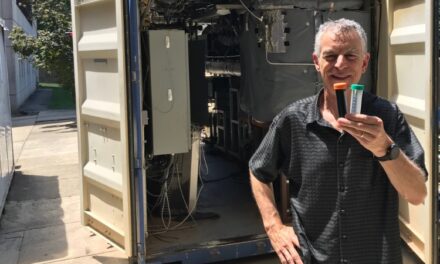starting a
Microbial Revolution
Now is the time to study the microbes in the environment, and their interactions with the human body.
-PreMiER Director Claudia Gunsch

Say the word “microbe” and many people reflexively reach for a bottle of disinfectant. But where most see an adversary to be destroyed posthaste, Claudia Gunsch has always seen potential. She believes that microbiomes — the communities of microorganisms thriving all around us — can be engineered to serve both environmental and human health.
“A lot of the work that I’ve done has focused on bioremediation,” said Gunsch, a professor of civil and environmental engineering at Duke University and the director of a new $26million, NSF–funded multi–institution center that focuses on engineering the microbiomes of indoor spaces. “That means I’ve been trying to figure out how we can engineer microbial communities to degrade pollutants and explore the connections between environmental contaminants and human health.”
That specialty led Gunsch to sites across North Carolina where creosote, a distilled tar used to preserve wooden telephone poles until the late 1990s, had leached into the surrounding soil, river sediment and groundwater over many decades. Gunsch’s lab was trying to determine whether fungal microbiomes existed at the sites despite toxic conditions, and whether they could be stimulated to actually break down the pollution.
In a separate project closer to home, she collaborated with Duke professor of environmental science and CEE Heather Stapleton on a study investigating the gut microbiomes of children in the Durham area. The results were surprising to Gunsch, despite her expertise.
“We were finding microbes in these children’s guts that you would never dream existed there,” said Gunsch. “These were organisms that we actually put in soil to detoxify its contaminants. And that really got me thinking — where are these children getting exposed to these compounds? And how is it affecting their gut microbiomes?”
It was a pivotal moment in her research. Gunsch began to think broadly about what additional areas of strength would be needed to fully understand and engineer the microbiomes in all the places where humans live, work and play. Building on a long-established training program with biology professor Joseph Graves at North Carolina Agricultural and Technical State University, Gunsch invited a host of collaborators from institutions within the state to tackle the challenge. Joining her in the new Engineering Research Center for Precision Microbiome Engineering, or PreMiEr for short, are:
- Jill Stewart, the Philip C. Singer Distinguished Professor of Environmental Sciences and Engineering at the UNC-Chapel Hill Gillings School of Global Public Health
- Joseph Graves Jr, professor of biological sciences at NC A&T
- Jennifer Kuzma, the Goodnight-NCGSK Foundation Distinguished Professor in the School of Public and International Affairs and co-director of the Genetic Engineering and Society Center at NC State
- Anthony Fodor, professor of bioinformatics at UNC Charlotte.
“The research center includes a core area for investigating the societal and ethical implications of microbiome engineering to innovate responsibly,” said Gunsch. “The truly interdisciplinary nature of the center is going to make real societal impact.”
Gunsch imagines that the new center will eventually enable diagnostic tools that can quickly identify the members of the microbial communities that surround us, revolutionizing approaches in agriculture, environmental health, human health and beyond. “Imagine a day when a doctor could walk into a hospital room and, with a really quick diagnostic test, be able to detect the presence of a pathogen before it affects an immunocompromised patient,” said Gunsch. The tools that the center aims to develop over the next several years, said Gunsch, may shift the imaginary into reality.



